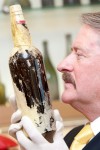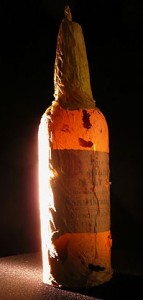Last summer, researchers from the Canterbury Museum in Christchurch, New Zealand thawed a crate of whisky found frozen solid under the floorboards of explorer Ernest Shackleton’s hut on Ross Island, Antarctica, in 2006. Whisky experts were all agog over the prospect of being able to analyze these spirits purchased for the expedition in 1907 because the original recipe for this brand, Mackinlay’s Rare Old Highland Malt Whisky, was long since lost. The bottles had been preserved in the deepest of deep freezes for a century and thus might provide all kinds of information about historical blends and distillation methods that you can’t get from whisky of the same age but that has lived a more active life.
 In January of this year, Richard Paterson and Dr. Vijay Mallya, respectively the master blender and owner of Whyte & Mackay, the company that owns the former Mackinlay’s distillery, flew to New Zealand on a private jet, picked up three bottles of Shackleton’s whisky then flew back with them to Scotland on the private jet. The cargo hold of a commercial plane would not have been able to provide the proper conditions for the safety and conservation of these precious, rare bottles, and obviously there are more than 3 ounces of liquid in the bottles, so they couldn’t fly in the passenger cabin either. Mallya volunteered his private plane for the task.
In January of this year, Richard Paterson and Dr. Vijay Mallya, respectively the master blender and owner of Whyte & Mackay, the company that owns the former Mackinlay’s distillery, flew to New Zealand on a private jet, picked up three bottles of Shackleton’s whisky then flew back with them to Scotland on the private jet. The cargo hold of a commercial plane would not have been able to provide the proper conditions for the safety and conservation of these precious, rare bottles, and obviously there are more than 3 ounces of liquid in the bottles, so they couldn’t fly in the passenger cabin either. Mallya volunteered his private plane for the task.
Paterson literally handcuffed himself to the protective cases the bottles were kept in for the duration of the voyage. He only detached himself from them under duress when customs made him. As a master blender and a nose, Paterson has an emotional bond to these bottles from a bygone era and the mysterious blend they contain. He’s the one who got to sample the whisky as part of the analytical process. The only other person allowed to taste it was whisky writer Dave Broom.
Here he is being adorably passionate about the whisky in a video from when it first arrived in Scotland. You can see the safety crates and the handcuffs in it:
[youtube=http://www.youtube.com/watch?v=KK2qQcgkM00&feature=player_embedded&w=430]
After that video was filmed, the bottles were taken to Whyte & Mackay’s laboratories in Invergordon where samples were extracted from each bottle by a syringe inserted through the stopper. Eight weeks of chemical and palate analysis ensued. The bottles were not opened or tampered with in any way, and they will be returned to the Antarctic Heritage Trust to be preserved along with their unsampled brothers.
Now Whyte & Mackay have announced the results of their study and their recreation of a replica of the Shackleton whisky. In two to eight weeks, 50,000 bottles of the replica whisky will be sold, starting in the UK then on to mainland Europe, the US, Australia and New Zealand.
Paterson expected the whisky to have a heavy, peaty flavor, which was the fashion at the time. Instead, according to his tasting notes, he discovered a Scotch with “delicate aromas of crushed apple, pear and fresh pineapple. It has a whisper of marmalade, cinnamon and a tease of smoke, ginger and muscovado sugar.”
[Rob Bruce, Whyte & Mackay’s head of global public relations] wouldn’t say much about the process Paterson used to create the replica.
“He used existing single malts, including liquid from the original Mackinlays distillery,” Bruce wrote in an email, referring to the company that made Shackleton’s stash. “We are not revealing any more than that at this stage.”[…]
Paterson’s tests revealed that the forsaken whisky has a 47.3 percent alcohol content, which is high. He believes this was to help prevent the liquid from freezing. The result, he said in his notes, is that it “gives plenty of impact, but in a mild and warming way. It has whispers of gentle bonfire smoke slowly giving way to spicy rich toffee, treacle and pecan nuts.”
The bottles will cost about $160 each, and 5% of the proceeds will be donated to the Antarctic Heritage Trust. If, as expected, the full run sells, the Trust will receive almost $400,000.
You can hear Dave Broom’s glowing review in this interview with Radio New Zealand. I’m not a whisky person but I have to admit it sounds delicious (although of course I wouldn’t care at all if it hadn’t come from Ernest Shackelton’s ice cellar).


That’s 94 proof. IIRC Rumplemintz peppermint schnapps is 100 proof – 50% alcohol. Crown Royal whiskey (my choice when indulging) is 80 proof.
Is that Crown Royal figure the norm for whiskey drinks?
It is for me. :p
80 is the limit for American whiskeys but I’m not sure if that applies to imports. CR is Canadian.
Oh yeah, and to add context to the freeze resistance thing in the article, Rumplemintz is stored in the freezer and is still liquid, though a bit thick.
Oh ya, I’ve stored vodka in the freezer and it gets syrupy but still flows. The replica Shackleton whisky is also 47.3% alcohol, so obviously Scotland doesn’t have the limits of America/Canada. I’m not sure why the alcohol content of whiskey is regulated anyway. You can just get a bottle of schnapps anyway, so why the teetotalling over the brown stuff?
Cool story! All those descriptions of fruits and spices make my mouth water; now, if only I liked whiskey (and could spare $160).
94 proof is high for a Scotch whisky, and I’m not surprised its purpose was to withstand the environment’s freezing temperatures.
When India was a British colony, the brewers of ale invented India Pale Ale, which was made deliberately with a high alcohol content, so that the ale would still have some potency by the time the casks arrived in India all the way from Britain.
I’m a Bourbon enthusiast myself, and $160 per bottle is outside my usual budget, but I may make an exception for this unique distillate.
Ainorite? I actively hate the smell of whiskey, but the description is so seductive.
eta Hey, you commented!
I did not know that. I guess that’s why they call it IPA, huh?
If you do, please be sure to report back so we can live vicariously through you.
As I understand it, it isn’t about limiting the content in a liquor to a certain level. I think it’s more like the restrictions on calling something champagne, it has to meet certain restrictions – most notably in that case, where it is made. So, a liquor can be made out of the same materials as whiskey and be stronger than 80 proof. It just has to be called something else.
Everclear is 190 proof, the highest that alcohol can be distilled to. Some states do prohibit selling anything stronger than 151.
Hi all, whiskey ABV ranges from 40% to about 60%. In order to be called Scotch Whiskey, the whiskey must be made in Scotland with barley, yeast and water and aged in an oak barrel for a minimum of three years. The ABV doesn’t play a part in defining Scotch, though most Scotch is released at 40%. When Scotch whiskey comes out of the cask, it is called cask strength and the ABV tends to range from 50% to 60% alcohol. However most whiskey is watered down to have an ABV of 40 to 46%.
Thank you kindly, Nick. That was a helpful explanation. :thanks:
Positive reinforcement is notd too bee better that punishment.
Pro dog training tip: Train your dog Monday through Friday, and allow
iit thee weekends off. For those of you who wasnt to enjoy a spoort or compete in an activity with your dog, you will need to move along to
more complex dog training.
Thanks for sharing this beautiful blog really awesome information.